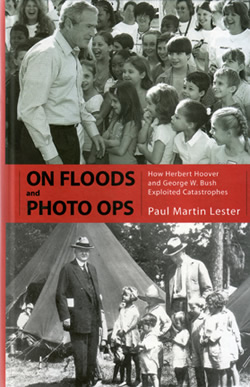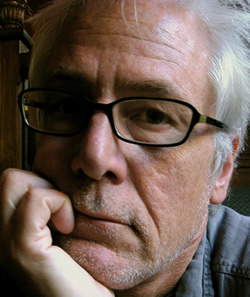On Floods and Photo Ops
Communications Professor Authors New Book
March 2, 2010
By Valerie Orleans
Two presidents. Two natural disasters. Two different eras. The same photo op.

The cover for “On Floods and Photo Ops: How Herbert Hoover and George W. Bush Exploited Catastrophes” written by Paul Lester and published by University Press of Mississippi.
When Paul Lester, communications professor and photo communications concentration chair, answered a call for papers from the academic journal, Visual Communication Quarterly, he didn’t realize this paper would serve as the foundation for his new book, “On Floods and Photo Ops: How Herbert Hoover and George W. Bush Exploited Catastrophes,” published by University Press of Mississippi.
“This issue of the quarterly was devoted to research studies and portfolios about Hurricane Katrina,” he said. “My idea was to find two pictures of politicians visiting survivors; one image would need to be President George W. Bush meeting victims after Hurricane Katrina. I then went in search of a photo of another politician, performing in the same photo op set-up, but at the site of a different disaster.”
The idea was to study, in detail, the similarities and differences in order to draw conclusions about political photo ops over the years.
Lester found a photo of President Bush visiting schoolchildren in DeLisle, Miss., less than two months after the devastation left by Katrina. While searching for the Bush photo, Lester remembered a radio interview that described the disaster that followed the Great Mississippi Flood in 1927. A search turned up the photo of Herbert Hoover standing beside a man next to barefoot children.
“These photos, at first glance, would probably not warrant a second look,” Lester admits. “The pictures are obviously set-up and stage-managed by the staff of the presidents to advance their own political agendas and self-interest.

Paul Lester
“But it is precisely because of their mutual banality that they were chosen for this book,” he said. “The idea is that a thorough examination of any photograph, whether marvelous or mundane, should reveal hidden connections and understandings.”
Lester has a history of looking at the ethics of photojournalism. As a photojournalism student at the University of Texas, Austin, and later as a staff photographer for the Times-Picayune newspaper in New Orleans, he would come across situations where he needed guidance concerning the ethics of shooting, let alone publishing, certain photos.
“There was nothing to help me,” he said. “No book. No guidelines. Nothing.”
So, while studying for his doctorate at Indiana University, he wrote his dissertation on the ethics of photojournalism. Eventually, the dissertation was turned into his first book, “Photojournalisim: An Ethical Approach.”
While conducting research for his latest book, Lester would use the photos as examples in his classes.
“Every semester, in my visual communications class, I would have my students analyze either the Hoover or Bush photo. In many ways, the students helped me focus on the photos while I was working on my manuscript,” he said.
“I guess what I hope people will take away after reading the book is to take the time and energy to really look at ordinary photographs. If you do, you can learn about so many topics,” he said. “I like to quote Jacob Grimm: ‘Everything looked at closely is full of wonder.’ I want to make people look closely.”
Find more information on the book at its Amazon.com listing.

